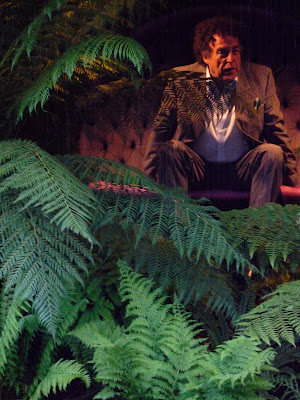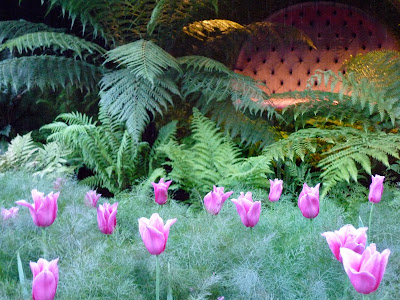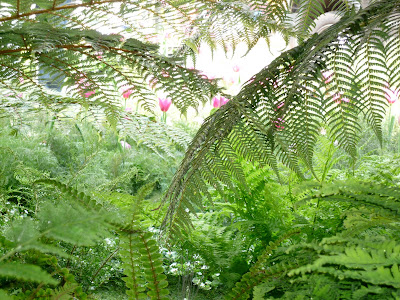One to watch…
Chelsea Flower Show is not just for those who know and follow the taxonomists and nursery plant fashions it is also for those art and culture buffs and the inner hippy that we all hold. It is the coolest thing about town at the moment – where else do you get such a giant collaborative effort towards aesthetic, thought provoking achievement. And what is more it is about greenness; about eco-lifestyle; outdoor-living; holistic working environments… Not to mention it has all the peeking curiosities of tantalising reveal and titillation, intrigue and inspiration for our own translations of these into our individual lifestyles.
Chelsea as a show…
A ticketed event, for the uninitiated it can seem like a pretty daunting prospect, an intrusion into our nation’s grand institution of the RHS; yet that is what it’s all about. It’s about showing off, touching base with design solutions, proposals and ideals. Like a peacock rippling its feathers, for the last 7 days we’ve seen designers and contractors at their best; preening after the recent frosts in the unusually fine weather. Building work’s going down fine and set-ups are running to schedule, and there is the faintest whiff of unsettlement over the plants and their adaptation to the strange weather conditions. With exotic species being used to push original briefs and concepts, they’ve been on their own journey through abnormally late frosts and brilliant sunshine, the fear it seems is that the plants will be scorched in both respects. Yet some are smilingly more smugly than others; the native plants are comfortable, relaxed and breathing freely. As an RHS Flower show one could argue that native plants should be the only ones on display for a more sustainable, eco-friendly and ‘true’ show. Yet this is not what Chelsea is about, for years it has pushed the boundaries using ‘smoke screens & mirrors’ – it is a spectacle and cannot be considered otherwise and as a world class, international show we expect glimpses into the metropolitan world, inspiration for our own design solutions or just simple food for thought. Although if we were to plant many of these species into our own back gardens, we might find many of them suffering as there is little ‘truth’ in their planting with this maritime site as their context. Within their brief and true to their brief yes they might be, but true to Brit gardens they are not.
Why it continues to attract and amaze…
Well that’s that then, we might argue, what then is the point in visiting the show, I’ll pass my ticket on to someone else…Hold your horses! Because it is actually saying something else it is opening our eyes to that sense of wonderment, providing optimism in the face of disaster, opening ourselves up to the belief in the impossible. A sense indeed that is drilled out of us from our early years, that a square cube does not fit through a round hole, that if something isn’t suited it won’t work. Yet here these gardens are, many of them defying the odds with exotic plants and flowers settling in, with huge and ancient trees making Chelsea their home for a few weeks only. These presentations are in themselves a mini-miracle pushing us to consider new products and uses; removing stifling categorization, considering instead possible opportunities found in the unexpected. What is more, the show allows us to think, to reconsider, to appreciate, to understand and to analyse to such a degree as we would not normally be allowed. Most gardens in themselves are private spaces, little used by the uninvited, yet Chelsea here is showing, has on display, examples of what is being achieved in outdoor spaces across the country. Ever since even before the era Mr and Mrs Andrews we can understand ourselves as Brits through our association with our land, our commodity, our property, our achievement; and here we are at Chelsea celebrating this very thing. There is no show quite like it simply because us Brits know how to celebrate our terrain.

Chelsea and Art
The art world has traditionally shown little interest in Chelsea, with Tony Smith’s fabulous concepts piquing their sole interest but surely it is time for it to wake up to Chelsea and there is a feeling that it might, that it just about is… Art and architecture have always enjoyed a happy marriage but not since the romantics has art and landscape architecture been so mixed - with the onset of green ideologies, of utopic alternatives and integration, and with art generally just getting bigger. Furthermore, contemporary art is concentrating on formation over product, of dialogue, exchange and viewer relationship. Curators are taking on more and more artistically creative roles themselves, and artists are continually subsuming the curator’s role. The holistic, collaborative, changing art is now. The green, eco, big art is now. The viewer, the individual’s journey in art is now. So where are we all looking? Chelsea! Where else can we look…there is nowhere better.
Where to look Show Gardens…
Robert Myers stands out this year, purely on scale, with a fine balance between dark and light, cube and sphere with a central enlightenment theme, challenging from any perspective.
Andy Sturgeon and Tom Stuart-Smith can hardly be separated in their description and emotive provocation of calm, harmony and balance – with outstanding results as can be expected.
Yet it’s perhaps that sense of agitation in what grates, what doesn’t work, what works unexpectedly which will always gain the wow factor. In which respect we may find ourselves drawn to the Leeds Garden, we shouldn’t like it but we do – with the monolithic sluice gushing forth water, a nod towards our transport heritage of our distant past and covered with naturalized planting. Really it is a simple celebration of the relationship and possible equilibrium held between man and nature; the pure fundamentals that we consistently search against and through: our own existence amid this big green one. Yet perhaps we might call this a little too romantic, a borrowing of Wordsworthian nostalgia.

For lines, for lush, for guidance through green wilds we might look instead at James Wong and David Cubero’s successful marriage of verticals, subtle, delicate yet impressive in its simplicity of concept, a reunion once again of these romantic ideals; or a sublime reflection inspired by our individual experience of lush greenery and wildscape. However it is not yet nostalgic; sublime, yes but without nostalgia, instead contemporary existence and lifestyle is here very conscious and self-aware. Rather than a recreation of an idyll à L’Occitane here we have a creation of a new one, innovative perhaps not, but contemporary yes. It is a piece, a work of art that is very now, very us. For all those interested in collaboration – not only has it been designed by two (James Wong and David Cubero) but both are international citizens based now in London bringing different cultural aspects to the fore; and the contractors here Landform, lead by Mark Gregory, pride themselves not only on their team effort between them but also on the give and take they have with their design team – which is indeed perhaps why they were chosen; allowing for a much more organic process in its installation and planting process. Furthermore, the team of plants women (and men), the helpers, have been on site since early in the construction, busy with their clippers and keen eyes, bringing the planting to life. A true example of liberal diplomacy at its best with double if not triple leadership of their micro-community, apt timing one might say, a parallel no doubt to be drawn with Cameron and Clegg.

Now and us
In so far as innovation is concerned, there are plenty of subtle firsts at Chelsea this year – firsts driven by technology and lifestyle choices with outdoor accessibility and urban use driving firsts for fire pits, pizza ovens and outdoor kitchens not to mention spas, water bars and porous easigrass. Yet for firsts in terms of pure artistic innovation we must instead look to Chelsea as a whole, to its holistic spread, its diverse presentation of themes and concepts and its quiet unison in sustainable drive. In Post-Modern Britain we lost our identity, perhaps it is at Chelsea that we might reclaim it - diverse, open, collaborative and busy, yet modest in relation to its real achievements and of course with a big dollop of sense of humour thrown in just to make that mix extra special (where else would you find a Rhubarb & Custard Garden) … Chelsea here we come, we call!!!!



























